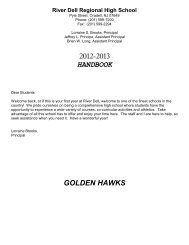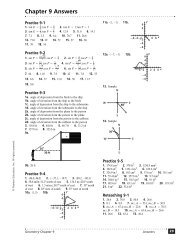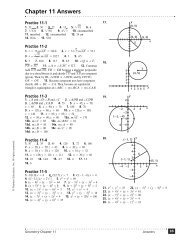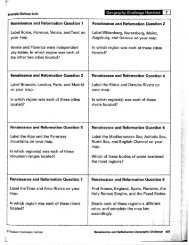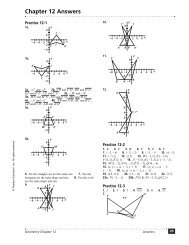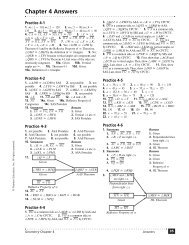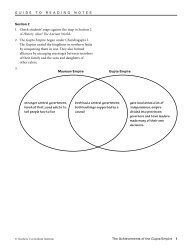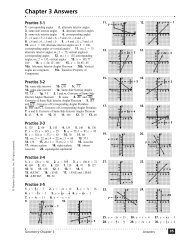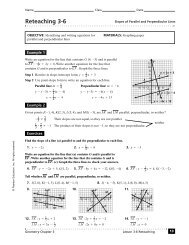Chapter 12 Sequences; Induction; the Binomial Theorem
Chapter 12 Sequences; Induction; the Binomial Theorem
Chapter 12 Sequences; Induction; the Binomial Theorem
Create successful ePaper yourself
Turn your PDF publications into a flip-book with our unique Google optimized e-Paper software.
<strong>Chapter</strong> <strong>12</strong>: <strong>Sequences</strong>; <strong>Induction</strong>; <strong>the</strong> <strong>Binomial</strong> <strong>Theorem</strong><br />
57. The total number of seats is:<br />
S = 25 + 26 + 27 + + ( 25 + 29()<br />
1 )<br />
This is <strong>the</strong> sum of an arithmetic sequence with<br />
d = 1, a1<br />
= 25, and n= 30 .<br />
Find <strong>the</strong> sum of <strong>the</strong> sequence:<br />
30<br />
S 30 = [ 2(25) + (30 − 1)(1) ]<br />
2<br />
= 15(50 + 29) = 15(79)<br />
= 1185<br />
There are 1185 seats in <strong>the</strong> <strong>the</strong>ater.<br />
58. The total number of seats is:<br />
( ( ( )))<br />
S = 15 + 17 + 19 + + 15 + 39 2<br />
This is <strong>the</strong> sum of an arithmetic sequence with<br />
d = 2, a1<br />
= 15, and n = 40 .<br />
Find <strong>the</strong> sum of <strong>the</strong> sequence:<br />
40<br />
S 40 = [ 2(15) + (40 − 1)(2) ]<br />
2<br />
= 20(30 + 78) = 20(108)<br />
= 2160<br />
The corner section has 2160 seats.<br />
59. The lighter colored tiles have 20 tiles in <strong>the</strong><br />
bottom row and 1 tile in <strong>the</strong> top row. The<br />
number decreases by 1 as we move up <strong>the</strong><br />
triangle. This is an arithmetic sequence with<br />
a1 = 20, d =− 1, and n = 20 . Find <strong>the</strong> sum:<br />
20<br />
S = [ 2(20) + (20 − 1)( − 1) ]<br />
2<br />
= 10(40 − 19) = 10(21)<br />
= 210<br />
There are 210 lighter tiles.<br />
The darker colored tiles have 19 tiles in <strong>the</strong><br />
bottom row and 1 tile in <strong>the</strong> top row. The<br />
number decreases by 1 as we move up <strong>the</strong><br />
triangle. This is an arithmetic sequence with<br />
a1 = 19, d =− 1, and n = 19 . Find <strong>the</strong> sum:<br />
19<br />
S = [ 2(19) + (19 − 1)( − 1) ]<br />
2<br />
19 19<br />
= (38 − 18) = (20) = 190<br />
2 2<br />
There are 190 darker tiles.<br />
60. The number of bricks required decreases by 2 on<br />
each successive step. This is an arithmetic<br />
sequence with a1 = 100, d =− 2, and n= 30 .<br />
a. The number of bricks for <strong>the</strong> top step is:<br />
a30 = a1 + ( n− 1) d = 100 + (30 −1)( −2)<br />
= 100 + 29( − 2) = 100 −58<br />
= 42<br />
42 bricks are required for <strong>the</strong> top step.<br />
b. The total number of bricks required is <strong>the</strong><br />
sum of <strong>the</strong> sequence:<br />
30<br />
S = [ 100 + 42 ] = 15(142) = 2130<br />
2<br />
2130 bricks are required to build <strong>the</strong><br />
staircase.<br />
61. The air cools at <strong>the</strong> rate of 5.5° F per 1000 feet.<br />
Since n represents thousands of feet, we have<br />
d = − 5.5 . The ground temperature is 67° F so<br />
we have T 1 = 67 − 5.5 = 61.5 . Therefore,<br />
T = 61.5 + n−1 −5.5<br />
{ }<br />
{ n} ( )( )<br />
= { − 5.5n+ 67 } or { 67 −5.5n}<br />
After <strong>the</strong> parcel of air has risen 5000 feet, we<br />
have T 5 = 61.5 + ( 5 −1)( − 5.5)<br />
= 39.5 .<br />
The parcel of air will be 39.5° F after it has risen<br />
5000 feet.<br />
62. If we treat <strong>the</strong> length of each rung as <strong>the</strong> term of<br />
an arithmetic sequence, we have 1 49 a = ,<br />
d = − 2.5 , and a = 24 .<br />
n<br />
n<br />
( )<br />
( n )( )<br />
( n )<br />
a = a + n−<br />
d<br />
1<br />
1<br />
24 = 49 + −1 −2.5<br />
− 25 =−2.5 −1<br />
10 = n −1<br />
11 = n<br />
Therefore, <strong>the</strong> ladder contains 11 rungs.<br />
To find <strong>the</strong> total material required for <strong>the</strong> rungs,<br />
we need <strong>the</strong> sum of <strong>the</strong>ir lengths. Since <strong>the</strong>re are<br />
11 rungs, we have<br />
11 11<br />
S<br />
11<br />
= ( 49 + 24) = ( 73)<br />
= 401.5<br />
2 2<br />
It would require 401.5 feet of material to<br />
construct <strong>the</strong> rungs for <strong>the</strong> ladder.<br />
<strong>12</strong>52<br />
© 2009 Pearson Education, Inc., Upper Saddle River, NJ. All rights reserved. This material is protected under all copyright laws as <strong>the</strong>y currently<br />
exist. No portion of this material may be reproduced, in any form or by any means, without permission in writing from <strong>the</strong> publisher.




